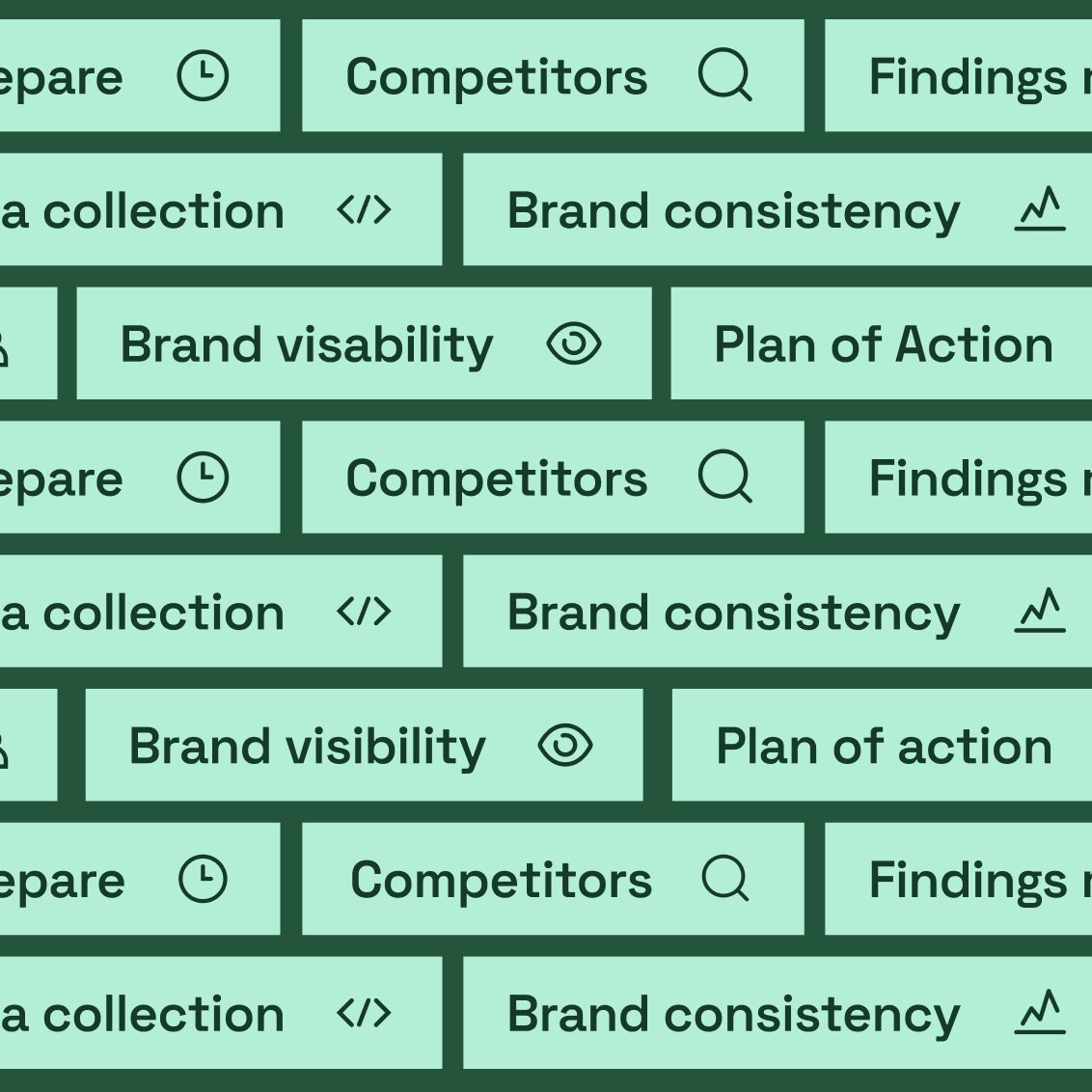What is a brand audit?
A brand audit takes a strategic look at your brand’s accomplishments, covering its goals, internal adoption, market position, and overall reputation. This exercise is typically carried out by brand managers and senior brand or marketing leaders.
You can work with a branding agency to get a neutral, third-party view of your brand’s performance. You can also use this step-by-step checklist and let your brand team run this exercise internally.
Benefits of conducting a brand audit
A brand audit aims to identify opportunities to improve your brand. This could mean spotting inconsistencies in how your brand is communicated internally or determining areas where your brand identity doesn’t match customer perceptions.
There are several benefits to running a brand audit:
- Measuring your brand’s performance
- Tracking internal brand engagement
- Discovering your brand’s strengths and weaknesses
- Understanding how your brand compares to competitors
- Improving brand performance and consistency
- Developing a more effective brand strategy
Your brand audit checklist
We put together an eight-step checklist to guide you through the process.
Step 1: Prepare for your brand audit

Before you dive into gathering data and analyzing performance, set clear objectives for the project. For example, are you most interested in how your brand works internally, or are you more focused on the external perception of your brand? While you’ll likely collect insights in both areas, working out your priorities and goals will help you optimize the auditing process.
You should also work out who to involve in your audit: Who are the key stakeholders, and what are their roles? Here are some of your most important collaborators and how they can support your brand audit:
- Business leaders (including the CEO and CMO): They can give high-level input about the brand’s value and identity and provide information on how investors or competitors perceive it.
- Brand managers: They have the most visibility into day-to-day branding efforts and will likely already track several key performance metrics. Brand managers will know about upcoming projects, including campaigns or rebranding initiatives.
- Marketing leaders: They can share ongoing marketing projects, campaigns, and activities, including how these perform. They also have insight into competitors and key differentiators.
- Sales leaders: They interact with customers regularly and will be most aware of how consumers perceive the brand and how it compares to others in your industry.
Step 2: Perform a competitive analysis
Competitor analysis is the ideal starting point for your brand audit and helps you understand your brand’s position in the market.
First, make a list of your most relevant direct and indirect challengers. Then, compare your brand’s positioning with those competitors. In particular, look at pricing, product quality, and messaging. Your sales leaders will likely have the best insights here, so get them to share their comparison documents.
Next, work through a SWOT analysis of your brand against your competitors. Cover these key areas:
Strengths: What does your brand do better than its challengers? Weaknesses: What do your competitors do better than you? Opportunities: What are the biggest opportunities for your brand right now? Threats: Are there any new brands that could be a threat?
The answers will help you identify what sets your brand apart and will provide a core element of your positioning and messaging.
Step 3: Gather essential data and insights
Now, you want to gather data about your brand from relevant sources. At this stage, just collecting information — don’t worry about identifying trends or patterns.
- Talk to customers: Use surveys to collect feedback about your brand. Find out what customers like and dislike about it and why they choose your product over competitors.
- Ask employees: Examine how employees in different departments describe your brand, values, and mission. Look for commonalities and differences between teams.
- Review collateral: Collect a random sample of brand collateral created by different departments and published on various channels.
- Measure asset usage: If you work with a DAM, check the system’s analytics to track how brand assets are used. To get a feel for engagement and adoption across the company, look at which teams employ your assets the most and which are the most frequently used assets.
These sources provide quantitative data and qualitative insights about your brand performance and perception, both internally and externally.
Step 3: Analyze brand consistency

Use the brand collateral you’ve collected to assess the levels of brand consistency across the business.
Organize your assets by department or channel. Then, check how successful your teams are at presenting a consistent brand across all channels. Look for visual coherence in logo usage, color palettes, and asset usage. You should also check for messaging consistency.
This will help you evaluate how well each department understands your brand and how successful you’ve been at achieving internal alignment.
Step 5: Assess brand visibility
Another aspect of a brand audit is to examine your visibility — its online and offline presence in the market.
There are several metrics to measure your brand’s performance and visibility:
- Brand awareness: The percentage of people who recognize your brand aided or unaided.
- Share of search: The percentage of online searches about your brand compared to competitors’ websites.
- Share of voice: The percentage of all online or offline mentions (or advertising) about your brand versus challengers.
- Brand mentions: The number of mentions of your brand on social media or in the news.
These metrics help you compare your brand presence with competitors. By tracking the numbers over time, you can see if your visibility is growing and your brand investments are paying off.
Step 6: Evaluate brand reputation
A brand audit allows you to understand how consumers and the wider market perceive your brand to find out if it has a good reputation or if there’s room for improvement.
You can track perception via a few key metrics:
- Brand preference: The degree to which consumers would choose your brand over your competitors’ solutions.
- Brand loyalty: How likely are customers to keep buying from your brand and continuously choose it over your competitors’ offerings?
- Sentiment analysis: Analyze online mentions of your brand (e.g., social media) to understand whether the sentiment behind these comments is positive, negative, or neutral.
Other ways to evaluate your brand reputation include checking review sites (like G2 or Capterra) to see what users say about your product. You can also collect insights directly from your customers (e.g., surveys) or ask your customer support team to share recent feedback.
Step 7. Report on audit findings
Once you’ve gathered and analyzed the data, put together a report on your findings. You may want to create different versions:
- A high-level report to share with company leadership
- An in-depth version for your brand and marketing teams
Your brand audit report will likely focus on three areas: consistency, visibility, and reputation. Grouping your findings into these areas will help other stakeholders understand your brand’s performance internally and externally.
Turn your quantitative data (e.g., brand visibility and reputation metrics) into visual charts and graphs to make them easy to digest. Pull out relevant quotes from qualitative insights (e.g., customer feedback and survey responses) that summarize the common themes or trends you’ve identified.
Step 8: Develop an action plan

Don’t let the valuable insights from your brand audit gather dust. Work with key stakeholders to develop an action plan to help strengthen your brand.
Here are some areas to focus on:
- Improving brand consistency: Plan specific tasks to improve engagement across internal teams and help each department better understand and adhere to your guidelines.
- Boosting brand visibility: Target channels or market segments where you lag behind competitors. Organize campaigns to boost visibility.
- Strengthening brand reputation: Use competitor insights and customer feedback to identify opportunities. Create a plan to address those perceived weaknesses to develop your brand’s reputation.
If your audit uncovers a lot of areas for improvement, it can be tempting to tackle everything at once. Prioritize follow-up actions based on your findings and determine the areas with the biggest impact. Set timelines and define responsibilities so it’s clear who will do what to turn your findings into tangible change for your brand.
Brand audits are an essential part of your brand strategy
A brand audit should give you actionable information, resources, and ideas to strengthen and improve your brand. These insights help inform your strategy, guide your ongoing efforts, and inform how everyone in the organization brings your brand to life.
That’s why it’s critical to conduct regular brand audits — every six to 12 months. By regularly checking your brand’s pulse, you spot inconsistencies or reputation challenges as they arrive and create a culture of continuous development and improvement. Use this checklist each time to give you a repeatable framework for evaluating and auditing your brand.

